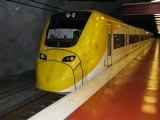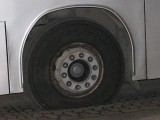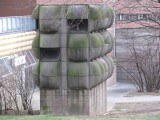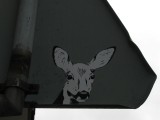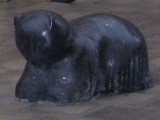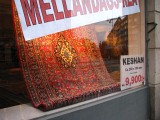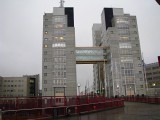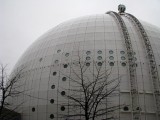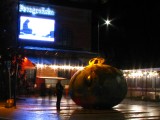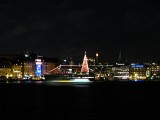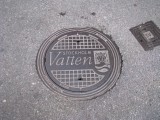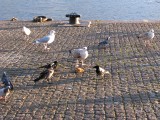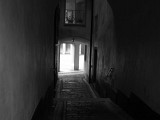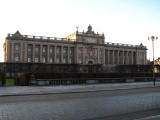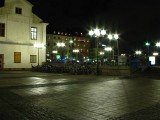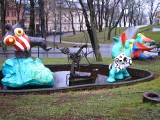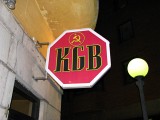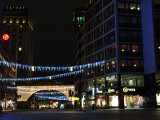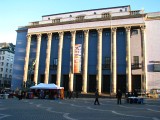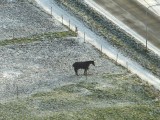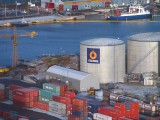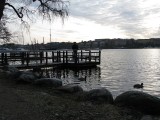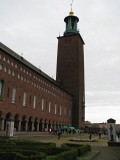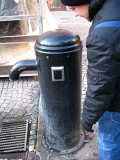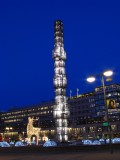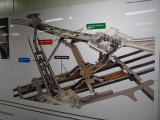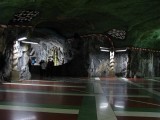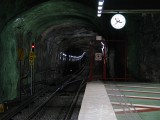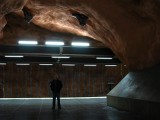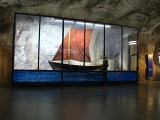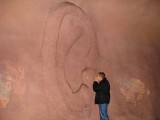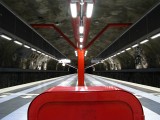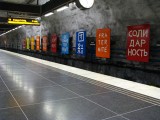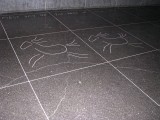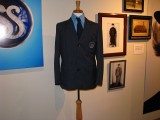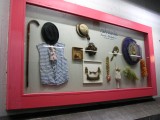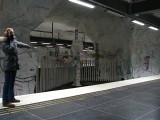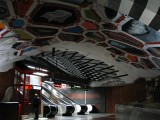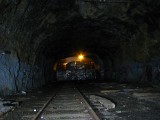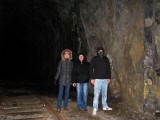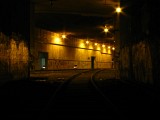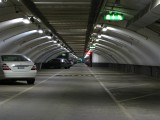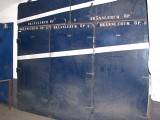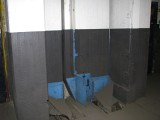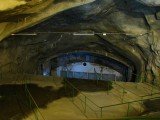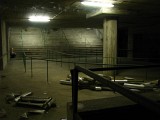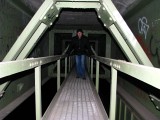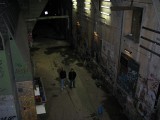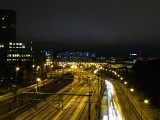The report on Volgograd diggers' being in Stockholm and their dream realization
TUNNELBANA (T-Bana)
Just Tunnelbana, in particular its photographs placed on someone's page in LiveJournal, became the main reason of our voyage. We'd had a strong desire, a fixation, to see this subway. “Tunnelbana is the only subway in Sweden . It is called “the longest art gallery in the world” . The decision to dig a subway appeared in 1941. The first underground lines had standards close to international ones but initially they were used for high-speed trams. The owner of Tunnelbana is SL Company. All the underground system includes 100 stations and three branched lines which have the total length of 105.7 km . 47 stations are underground and 53 – ground-based or overground. Lines have the left-side driving because for the moment of construction Sweden had also had the left-hand driving. Undoubtedly, the most interesting and intriguing thing of the Stockholm T-bana is the design. Every line (Green, Red or Blue) had been decorated in its own style. There are fairy grottos, ancient Greek sculptures, examples of the classic architecture, wall reliefs, mosaics, some kind of pop-art (giant galoshes on the ceiling of one of the stations), fountains and streams. Different exhibitions are often organized in T-bana. Some hundreds of artists have given their works to Stockholm subway. Earlier the Government had annually invested about 1.5 million dollars in this underground gallery. The Green line is the oldest, but the Blue line is the most pictorial”. (tunnelbana.ru) We devoted a whole day to the T-bana examination and observed all the stations of the Blue line. It was amazing! After we had seen these unprocessed rocks, the water running on the walls, muted illumination of platforms, sculptural compositions, mosaics and pictures we could not long come to our senses. Even in my dreams I was seeing the stations and the tunnels which are, apropos, not restricted by the dimension or form thanks to the dynamite using (in contrast to our tubings). Some stages exist there where two lines cross or go one above other or parallel for sometime. If I don't mistake, it was near the Gamla Stan where we were watching through the window how our train was competing with another one. We felt like in a fantastic movie… “The Blue line ( Bla Linjen), as it was said, is the youngest and the most beautiful line of Tunnelbana. Its first section opened in 1975. Excepting Kista region, this line is completely underground. All the stations have been made in a rock and have had 20- 30 m depth. They are broadly known because of the magnificent “cliff” pictures created by different artists. In addition, the section, where the line to Akalla goes overground, has a local ghost-station which has never been opened up. It, probably, will never open in the future because today this station is situated in a reserved area created by the Government. The Blue line includes 20 stations in general. 19 of them were built in rock and one is ground-based. The station Vastra Skogen possesses the longest escalators and Kungstradgarden is the lowest station in Stockholm relative to the sea level ( -29.3 m ). The longest stage goes between Kista and Hallonbergen». The word “Kungstradgarden” is translated as a “King's garden” and represents the name of a park in the city center. We liked this T-bana station most of all. “Its construction was linked with many scandals. One of the entrances should have been built directly in the park. It could have brought about the cutting down of a big number of old trees. In July 1970 citizens revolted against the annihilation of the ancient elms in the park. People protested by chaining themselves to the trees' trunks. 30 October 1977 only the station was finally opened. Now it is the terminal station of both branches of the Blue line. It is situated in the Norrmalm district and has about 34 m depth. Kungstradgarden got its decoration thanks to Ulrik Samuelson, a Swedish artist. He drew the inspiration from the architecture of the near famous palaces. (But it's not very clear where in these palaces the artist could have found the signs of radioactivity which now decorate the arch near the escalators… And what did he mean? – author's remark). The statue of a redskin man may be considered as a boss of the station. It personifies the God of War. You can also see there a lot of architectural elements of antique style.” Looking through the Internet reviews I understood that many tourists consider Tunnelbana a bit somber. As for me, it's not true. I think that by the help of this specific lighting the architects could get a sensation of people integrating with the station as well as better underline the beautiful relief of arches and walls. People whose hobbies are speleology or “digging” could even have an illusion of stay in a real cave sometimes. The Red and the Green lines are half ground-based. We saw only some of their central stations. These lines remind of a standard European subway much more. On the whole, we noticed that T-bana represents a model Metro if we mean cleanness, quality of rolling-stock and density of passenger traffic. This little traffic, strictly speaking, let us take some interesting photos which you can see here now. And another unusual thing in T-bana! It is a rule for drivers to quit their cabins every time the train is standing at the station and to supervise the boarding. We supposed it might be a special Swedish program of health protection: sit down and stand up every two minutes not to have problems with the tubules and the backbone. It is very laudable! Bent stations are also provided with additional monitors to help the drivers see the entire platform.
|
|
|
Sallies
Undoubtedly, we could not even dream about any underground sallies when we were planning our trip to Stockholm . By the way it became real thanks to the digger nicknamed Mirage. Of course, I won't point out the residence of the “places” we have seen. As in our native Volgograd all the sallies took place late at night. First of all, we visited a deserted tunnel which had been formerly used to carry over different shipment from the city to the port. It is remarkable that there is not much rubbish inside, not counting an innumerable number of graffiti, and somewhere we could have seen intact metallic objects, for example, rails and holders. We passed into the rock about 0.5 km and then the tunnel came to the surface. Some time we had been going in the dark on the icy ties before we turned on the next gate behind which the tunnel continued. After a while we found a huge door protecting some considerable underground lodgment. Mirage supposed it might be a bomb shelter of the hospital placed above. By walking through tunnels we were speaking a lot. So, we knew that the diggers of Stockholm also use bolt cutters and call them “universal keys.” :) Suddenly the tunnel led us to the deepened suburban train station functioning nowadays (J-line). Mirage offered us to exit there. We agreed. Our “emersion” could have been complicated because of the mounters swarming on the platform but, fortunately, they either didn't observe us or didn't have time to react. The next evening there was a survey of two civil defense shelters, and the first of them was the biggest shelter of Sweden ! You can see its scheme in the photo. Mirage told us that during the Cold War Sweden was afraid of the USSR very much and built numerous shelters. I found this information very interesting because in Russian textbooks on modern history the mentions of Sweden are extremely rare. In other words, the Soviet Union had neither time nor forces to spend them to Sweden... However I've digressed and beg a pardon. Thus, the three-story shelter was built in 1957 to admit, in a case of danger, 20 000 people. Besides there are special reservoirs for storing fuel. This bunker also connects up with T-bana but the door is surely locked. At the moment the shelter successfully functions as an underground parking (this variant was foreseen by the constructors). It is an excellent example of political prescience: such a huge lodgment shouldn't stay useless anyway – if a nuclear war doesn't start or (God forbid!) if it does. The second bunker was located not far from the first. It is remarkable for its split-level system of entrance-exit which lets divide people flows running from different sides and prevent a jam. Today the EMERCOM of Sweden headquarters there. The last unofficial place we visited in Sweden was the subway-bridge. It was charming! I noticed that during all our passage above the channel we saw no one rotten, rusty or dangerous place. Everything was built to last and looked as if the overhaul finished the day before. So, we could look down without any fear and go without holding on to the railing (of course, it is impossible in Russia when you are at the high altitude). We found one place on the bridge from where it might be possible to get to the T-bana tunnel. The narrow hole into the wall could let squeeze through it and fall out directly to the rails. However the level difference is about 2 m there. So, the way back would have been very problematical. J This time we decided not to risk by imaging if there was The Voice of Mind with us (our friend-digger who often prevents our crazy experiments). P.S. We loved Stockholm very much! Now I can remember nothing that we didn't like. Everything was great! And we want to thank all the diggers and explorers from 28dagarsenare.se for the given information. Mirage, especially thank You! Viva the First International “Union Ground Connection” 2012! And welcome to Russia! :) 22.01.12 Aislin. |
